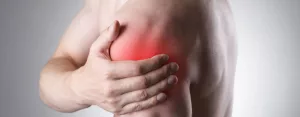 It is a lot easier to discover shoulder pain when pitching than to discover what is causing the problem. The glenohumeral joint, or the shoulder, is an extremely complex part of the body because it is multi-directional. The joint can horizontally and vertically abduct and adduct. Because of this it may take a physiology degree to understand all the things that can go wrong with the shoulder joint when pitching but in this article, I will list the most common problem and how to cure it and or prevent it from happening.
It is a lot easier to discover shoulder pain when pitching than to discover what is causing the problem. The glenohumeral joint, or the shoulder, is an extremely complex part of the body because it is multi-directional. The joint can horizontally and vertically abduct and adduct. Because of this it may take a physiology degree to understand all the things that can go wrong with the shoulder joint when pitching but in this article, I will list the most common problem and how to cure it and or prevent it from happening.
How I Tore my Rotator Cuff Pitching
I will never forget my senior year in high school when the pain in my arm started getting worse. I was so thankful that it did not get really bad until after my high school season. We went as far as our high school had ever gone in the state playoffs and lost in the semi-finals to the team that had won the last 6 state championships for 4A. That summer I was working with a conventional pitching coach and every time he told me to change something, my arm hurt worse. I remember it getting so bad I could not even bare the pain anymore. I started to go to doctors for the pain and all they would do is give me a cortisone shot. I had 3 or 4 of them before I said this isn't working.
It all ended my first appearance in junior college baseball. I had been given a full scholarship to play for Delgado Community College that had and still has a great baseball program. During that first outing it was like out of a movie. It was the fourth inning and I was doing well but the pain was excruciating. I was on like 1000 mg of ibuprofen and my entire arm was rubbed down with icy hot. In between innings I had to hit my arm, so I would feel the pressure from the pounding on my arm instead of the throbbing shoulder pain. The last pitch I made I heard something pop. My heart jumped out of my chest and I looked at my coach and he immediately knew something was wrong. He had to take me out because I could not move my arm. I then learned that I had torn my rotator cuff and had to have surgery.
I am telling my story because this is the typical chain of events that can happen to any pitcher who does not listen to his body and discover what is causing the shoulder pain. Studies have shown over 50% of pitchers pitch with some type of arm pain. Here is the study to prove it, the results may be shocking to some:
Effect of pitch type, pitch count, and pitching mechanics on risk of elbow and shoulder pain in youth baseball pitchers.
Lyman S, Fleisig GS, Andrews JR, Osinski ED. - American Sports Medicine Institute, Birmingham, Alabama. American Baseball Foundation, Birmingham, Alabama 35205, USA. - Am J Sports Med. 2002 Jul-Aug;30(4):463-8.
The 476 pitchers made 3789 pitching appearances during the season. Nearly 7% of all pitching appearances (254 of 3789) resulted in elbow pain, with 28% of all subjects
(134 of 476) reporting elbow pain at least once during the season. More than 9% of all pitching appearances (353 of 3789) resulted in shoulder pain, with 35% of all subjects (165 of 476) reporting shoulder pain at least once during the season. Overall, almost 15% of all pitching appearances resulted in elbow or shoulder pain, with half (50%) of all subjects reporting elbow or shoulder pain during the season.
Source - http://www.ncbi.nlm.nih.gov/pubmed/12130397
If you fall into this 50% or someone you know, then the information below is what will save your career or their career and also this information would have also saved mine!
Preventing or Overcoming Shoulder Injury
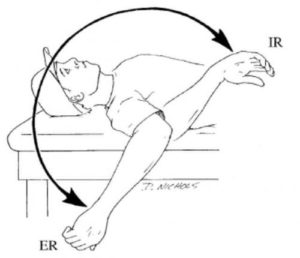 OK, so permanently curing something is a bit of an overstatement. There really isn't a permanent cure to pain unless you don't want to play baseball anymore. Pain is apart of the game but preventing this pain from becoming injury is the key to a successful career. If we are going to prevent or overcome shoulder pain or injury we need to first understand what causes the damage.
OK, so permanently curing something is a bit of an overstatement. There really isn't a permanent cure to pain unless you don't want to play baseball anymore. Pain is apart of the game but preventing this pain from becoming injury is the key to a successful career. If we are going to prevent or overcome shoulder pain or injury we need to first understand what causes the damage.
There are too many diagnoses of shoulder pain to cover in this one article. I will instead stick to one of the most common diagnoses of shoulder pain which studies believe will predict injury. This diagnoses is called GIRD. This stands for Glenohumeral Internal Rotation Deficit or more simply put, the loss of range of motion in the shoulder.
Frequently through your baseball career you should be monitoring the range of motion in your shoulder. To understand how this range of motion must work you need to make sure you have a good understanding of its movements. The shoulder does abduct and adduct which means it goes up and down, but more importantly, for the purpose of throwing a baseball, it internally and externally rotates. To understand this movement, hold your throwing arm at 90 degrees and position your elbow just above your shoulder height. Now, keep your arm at 90 degrees and role your arm forward like a catapult launching the object. Now, role the arm backwards like the catapult is loading the object. The amount of arc the hand covered is your range of motion. There needs to be the same amount of internal rotation arc as external rotation arc. If there is less internal rotation arc than external rotation then this means the shoulder is losing integrity or a balance of strength. Here is a journal from the US National Library of Medicine National Institutes of Health, which explains more about this condition of the throwing shoulder and it also lists ways to improve the problem.
Shoulder Pain in the Overhead Throwing Athlete
Shane T. Seroyer, MD,* Shane J. Nho, MD, Bernard R. Bach, Jr, MD, Charles A. Bush-Joseph, MD, Gregory P. Nicholson, MD, and Anthony A. Romeo, MD - Sports Health. 2009 March; 1(2): 108–120.
Verna (unpublished data, 1991) prospectively followed a group of professional baseball pitchers with glenohumeral internal rotation deficit (GIRD) of at least 35°. Sixty percent of these subjects developed shoulder problems requiring them to stop pitching between spring training and the end of the season. Burkhart et al suggested that approximately 90% of throwers with symptomatic GIRD will respond to a posteroinferior capsular stretching program. Acceptable limits of internal rotation deficit are less than a 20° loss of internal rotation compared to the contralateral arm or 10% of the total rotation of the contralateral arm. Early conservative treatment with “sleeper stretches” of the posteroinferior capsule can be very successful in returning the symptomatic thrower to competition. Off-season strength, conditioning, and stretching programs may prevent or mitigate this pathologic motion from developing and decrease the likelihood of labral and rotator cuff pathology developing throughout the season. Symptomatic throwers who do not respond to conservative management may require a selective posteroinferior capsular release followed by an immediate postoperative internal rotation stretching program. Rotational profiles of each thrower should be accurately monitored.
Source - http://www.ncbi.nlm.nih.gov/pmc/articles/PMC3445067/
The Steps to Alleviating Shoulder Pain
We now should have a good understanding of the dangers to the loss of range of motion in the shoulder and some tips to alleviating the pain that may come with it. More importantly, the ways to prevent damaging the shoulder. So, if you are experiencing shoulder pain or you are experiencing some GIRD, then here is some steps to cure, for this moment in time, your shoulder problems.
 Stop throwing for a few weeks - I know you hate to hear this but you really need to stop the damage and the throwing is what is causing it. All you need to do is tell yourself and your coach I just need two weeks. This should give you enough time to see if you can get it back in shape. If two weeks doesn't work then you need to see a doctor to make sure nothing more serious has occurred.
Stop throwing for a few weeks - I know you hate to hear this but you really need to stop the damage and the throwing is what is causing it. All you need to do is tell yourself and your coach I just need two weeks. This should give you enough time to see if you can get it back in shape. If two weeks doesn't work then you need to see a doctor to make sure nothing more serious has occurred.- Measure for GIRD - Use a Goniometer to measure internal rotation and external rotation range of motion (See picture).
 Sleeper Stretch - This will help improve internal rotation range of motion for those who have lost this range of motion.
Sleeper Stretch - This will help improve internal rotation range of motion for those who have lost this range of motion.- Throwing Mechanics - Use the 3X Pitching Velocity Programs to improving throwing mechanics. Specifically focus on more hip to shoulder separation to activate the throwing arm later in the delivery. This will put the arm into more shoulder abduction during external rotation which will activate more lats than rotator cuff, reducing the loads placed on the shoulder joint.
- Joint Integrity Program - Use the 3X Pitching Velocity Programs Joint Integrity routines weekly to build and maintain optimal joint integrity. These programs go from the off-season through the pre-season and into the season.
Heal Your Arm Now with the Latest in Science
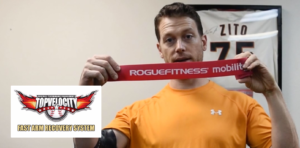 This Fast Arm Recovery System uses a 4 week System Calendar proven to heal the arm and rebuild it ASAP to get you back to the game. NOT INTENDED TO REPLACE AN OFF-SEASON DEVELOPMENT PROGRAM LIKE THE 3X AND 2X PROGRAMS.
This Fast Arm Recovery System uses a 4 week System Calendar proven to heal the arm and rebuild it ASAP to get you back to the game. NOT INTENDED TO REPLACE AN OFF-SEASON DEVELOPMENT PROGRAM LIKE THE 3X AND 2X PROGRAMS.
This system includes two phase of training with 8 different components. The first step or phase was developed to speed the healing process and the second step or phase was built to speed the strengthening and recovery process.
If you are in pain and need help immediately to get back to the season in weeks then this is the course for you. If you are concerned about injury this isn't here to replace a doctor. Please visit a doctor before starting this course if you are injured.



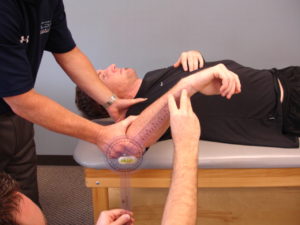 Stop throwing for a few weeks - I know you hate to hear this but you really need to stop the damage and the throwing is what is causing it. All you need to do is tell yourself and your coach I just need two weeks. This should give you enough time to see if you can get it back in shape. If two weeks doesn't work then you need to see a doctor to make sure nothing more serious has occurred.
Stop throwing for a few weeks - I know you hate to hear this but you really need to stop the damage and the throwing is what is causing it. All you need to do is tell yourself and your coach I just need two weeks. This should give you enough time to see if you can get it back in shape. If two weeks doesn't work then you need to see a doctor to make sure nothing more serious has occurred.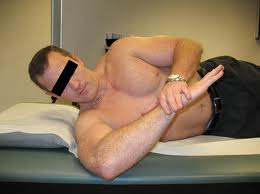 Sleeper Stretch - This will help improve internal rotation range of motion for those who have lost this range of motion.
Sleeper Stretch - This will help improve internal rotation range of motion for those who have lost this range of motion.
Before throwing I always warm-up with a 1lb ball and do some stretches. I realized I needed to do this in order to prevent pain. Great info!